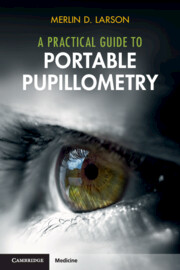Book contents
- A Practical Guide to Portable Pupillometry
- Reviews
- A Practical Guide to Portable Pupillometry
- Copyright page
- About the Author
- Contents
- Preface
- Acknowledgements
- Glossary
- Introduction
- Chapter 1 Early History of the Pupil
- Chapter 2 Anatomy of the Pupil
- Chapter 3 Physiology of the Pupil
- Chapter 4 Pharmacology of the Pupil
- Chapter 5 Unusual Pupillary Syndromes
- Chapter 6 Measurement of the Pupil
- Chapter 7 Pupil Size
- Chapter 8 Pupillary Light Reflex
- Chapter 9 Pupillary Reflex Dilation
- Chapter 10 Measuring Inhibition at the EW Nucleus
- Chapter 11 Traumatic Brain Injury, Cardiac Arrest, Intensive Care
- Chapter 12 Opioid Effect and Acute Pain
- Chapter 13 Anisocoria
- Chapter 14 Case Reports
- Conclusion
- References
- Index
Chapter 12 - Opioid Effect and Acute Pain
Published online by Cambridge University Press: 14 November 2024
- A Practical Guide to Portable Pupillometry
- Reviews
- A Practical Guide to Portable Pupillometry
- Copyright page
- About the Author
- Contents
- Preface
- Acknowledgements
- Glossary
- Introduction
- Chapter 1 Early History of the Pupil
- Chapter 2 Anatomy of the Pupil
- Chapter 3 Physiology of the Pupil
- Chapter 4 Pharmacology of the Pupil
- Chapter 5 Unusual Pupillary Syndromes
- Chapter 6 Measurement of the Pupil
- Chapter 7 Pupil Size
- Chapter 8 Pupillary Light Reflex
- Chapter 9 Pupillary Reflex Dilation
- Chapter 10 Measuring Inhibition at the EW Nucleus
- Chapter 11 Traumatic Brain Injury, Cardiac Arrest, Intensive Care
- Chapter 12 Opioid Effect and Acute Pain
- Chapter 13 Anisocoria
- Chapter 14 Case Reports
- Conclusion
- References
- Index
Summary
The fact that opioids constrict the pupil is known to healthcare workers and the lay public. In this chapter, the mechanism of this effect is discussed and how an understanding of this mechanism can be useful to the clinician. There are many parameters that can be measured from the pupil with portable pupillometers. The measure that most closely predicts the onset of severe respiratory depression is pupillary unrest in ambient light (PUAL). This measure is compared to pupil size and pupillary constriction amplitude as a measure of toxic levels of opioids.
Keywords
- Type
- Chapter
- Information
- A Practical Guide to Portable Pupillometry , pp. 101 - 112Publisher: Cambridge University PressPrint publication year: 2024

